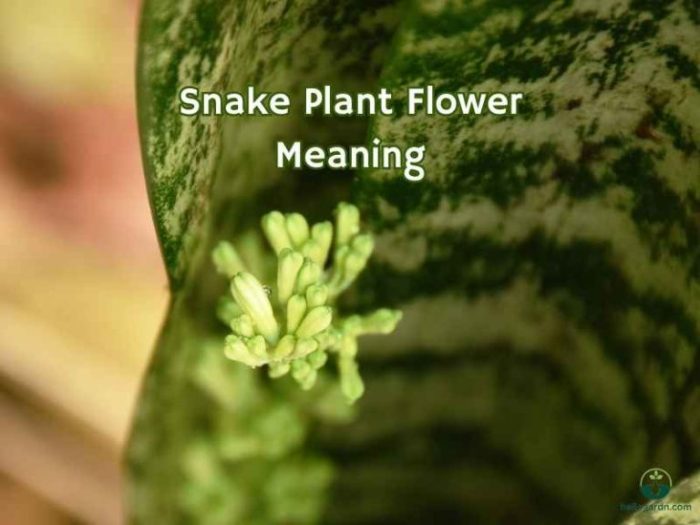Cultural Interpretations of Snake Plant Blooms

Snake plant flowering meaning – The infrequent flowering of the snake plant, a notoriously low-maintenance houseplant, imbues the event with a heightened significance in various cultures. This rarity contributes to the development of diverse and often fascinating interpretations, reflecting the unique beliefs and perspectives of different communities. While scientific explanations focus on environmental triggers, cultural interpretations delve into the symbolic meaning attached to this uncommon botanical occurrence.
Cultural beliefs surrounding snake plant blooms vary considerably across geographical regions and traditions. These interpretations often intertwine with broader beliefs about nature, prosperity, and even spirituality. The rarity of the bloom itself frequently amplifies its symbolic weight, transforming a simple botanical event into a potentially auspicious or ominous sign, depending on the cultural lens through which it is viewed.
Snake Plant Blooms in East Asian Cultures
In some East Asian cultures, the snake plant’s bloom is associated with good fortune and prosperity. The appearance of the delicate, often fragrant flowers is seen as a positive omen, suggesting good luck and potential financial gains in the coming period. This positive interpretation likely stems from the plant’s resilience and ability to thrive in challenging conditions, symbolizing perseverance and success in overcoming obstacles.
The rare bloom of a snake plant, signifying good fortune and prosperity in some cultures, contrasts sharply with the vibrant displays of autumn. For those seeking a similar burst of color, consider the stunning array of fall flowers to plant in pots , offering a rich palette to complement your home’s ambiance. Ultimately, both the snake plant’s infrequent flowering and the seasonal beauty of autumnal blooms represent nature’s enduring gift of breathtaking displays.
The vibrant colors of the flowers further enhance this association with vitality and abundance.
Snake Plant Blooms in Western Cultures
In contrast to the generally positive interpretations in East Asia, Western cultural interpretations of snake plant blooms are less established and widely varied. The rarity of the event often leads to online discussions and speculation, with interpretations ranging from simple curiosity to more mystical interpretations. While there isn’t a widely accepted symbolic meaning in Western folklore, the event is frequently met with surprise and excitement, often shared on social media platforms, demonstrating a collective interest and fascination.
The lack of a deeply ingrained cultural interpretation reflects the plant’s relatively recent introduction and integration into Western households.
Comparing and Contrasting Cultural Interpretations
A comparison reveals a stark difference between the established positive connotations in some East Asian cultures and the less defined, more varied interpretations found in the West. This disparity highlights the influence of cultural context and historical interactions with the plant. The East Asian perspective, often rooted in established traditions and folklore, contrasts with the Western approach, which is characterized by a more recent engagement and a lack of deeply entrenched symbolic associations.
The difference underlines how the meaning attributed to natural events is heavily shaped by cultural beliefs and societal values.
Care Practices and Flowering

Snake plant flowering, while infrequent, is a testament to the plant’s overall health and the effectiveness of its care regime. Several factors contribute to the likelihood of a snake plant producing its unique, often fragrant blooms. Understanding these factors allows for the cultivation of conditions conducive to flowering.Proper care practices significantly influence the probability of a snake plant flowering.
While not guaranteed, consistent application of these practices increases the chances of witnessing this botanical event. Neglect, on the other hand, often results in a plant that prioritizes survival over reproduction, thus inhibiting flowering.
Watering Practices and Flowering
The frequency and method of watering directly impact a snake plant’s ability to flower. Overwatering leads to root rot, a significant stressor that prevents the plant from allocating resources to flowering. Conversely, underwatering can also hinder flowering, as a stressed plant prioritizes survival. The ideal watering practice involves allowing the soil to dry out completely between waterings, ensuring the pot has adequate drainage to prevent waterlogging.
Consistent, moderate watering, allowing for complete soil dryness between waterings, creates an environment where the plant is neither stressed by drought nor overwhelmed by excess moisture, conditions that encourage flowering. For example, a snake plant consistently watered only when the top inch of soil is completely dry is more likely to flower than one subjected to frequent, shallow watering.
A Care Guide for Promoting Snake Plant Flowering, Snake plant flowering meaning
The following guide Artikels conditions that, when consistently met, increase the likelihood of snake plant flowering. These conditions focus on mimicking the plant’s natural environment, reducing stress, and providing optimal growing conditions.
- Bright, Indirect Light: Avoid direct sunlight, which can scorch the leaves, but ensure the plant receives ample bright, indirect light. A south-facing window with a sheer curtain is ideal in many climates. This mimics the conditions found in the plant’s native habitat.
- Well-Draining Potting Mix: Use a well-draining potting mix specifically formulated for succulents or cacti. This prevents waterlogging, a common cause of root rot and stunted growth. A mix of potting soil, perlite, and coarse sand works well.
- Consistent Watering: Water thoroughly only when the top inch of soil is completely dry. Allow excess water to drain completely from the pot. Avoid letting the plant sit in standing water.
- Appropriate Temperature and Humidity: Maintain a consistent temperature between 65-80°F (18-27°C). Average household humidity is usually sufficient; however, slightly higher humidity can be beneficial.
- Minimal Fertilization: Fertilize sparingly, only during the active growing season (spring and summer), using a balanced, diluted fertilizer. Over-fertilization can stress the plant.
- Avoid Frequent Repotting: Snake plants prefer to be slightly root-bound. Repot only when necessary, typically every 2-3 years, or when the roots become severely overcrowded.
Comparing Snake Plant Flowering to Other Succulents

Snake plants, known for their striking foliage, are not frequently associated with showy blooms. Their flowering, when it occurs, differs significantly from many other succulent species, both in terms of visual presentation and frequency. Understanding these differences provides valuable insight into the diverse reproductive strategies employed within the succulent family.The infrequent and often subtle flowering of snake plants contrasts sharply with the often vibrant and abundant displays seen in many other succulents.
While some succulents boast large, colorful flowers that attract pollinators readily, the snake plant’s flowers are typically smaller, paler, and less visually striking. This difference in floral display is directly linked to the different evolutionary pressures and ecological niches these plants occupy.
Flowering Frequency and Patterns
The infrequent flowering of snake plants, often occurring only after several years of established growth under ideal conditions, contrasts with the more regular flowering observed in many other succulent genera. For example,
- Echeveria* species frequently bloom annually, producing clusters of vibrant flowers on tall stems. Similarly,
- Haworthia* and
- Aloe* plants often exhibit more predictable flowering cycles. These differences are influenced by factors such as plant maturity, environmental cues (like photoperiod and temperature), and specific species genetics. The snake plant’s infrequent bloom can be interpreted as a strategy optimized for energy conservation, prioritizing vegetative growth over frequent reproduction. Conversely, the more frequent flowering in other succulents may reflect a strategy to maximize reproductive opportunities in potentially less stable environments.
Cultural Interpretations of Succulent Blooms
While the cultural significance of snake plant flowering remains relatively unexplored compared to its ornamental value, many other succulents hold deep cultural meaning in various societies. For instance, cacti, particularly in Mexico and the southwestern United States, are often associated with resilience, strength, and survival in arid landscapes. Their blooms, frequently appearing after periods of drought, are seen as symbols of hope and renewal.
Similarly, certainAloe* species are highly valued for their medicinal properties, and their flowering can be linked to concepts of healing and well-being. The cultural interpretations surrounding succulent blooms often reflect the plant’s role within a specific culture’s history, mythology, and practical applications. These interpretations often lack the widespread, established traditions associated with the blooms of other, more common flowering plants.
User Queries: Snake Plant Flowering Meaning
How long does a snake plant flower last?
It varies, but usually a few weeks. Enjoy it while it lasts!
Can I propagate from the flower stalk?
Nah, usually not. The flower stalk doesn’t produce viable plantlets like some other succulents.
My snake plant is flowering, does that mean it needs something?
Not necessarily. It’s just a natural part of its life cycle, though it might indicate it’s happy with its current environment.
What if my snake plant never flowers?
Don’t stress! It’s totally normal. Many snake plants never flower indoors.










